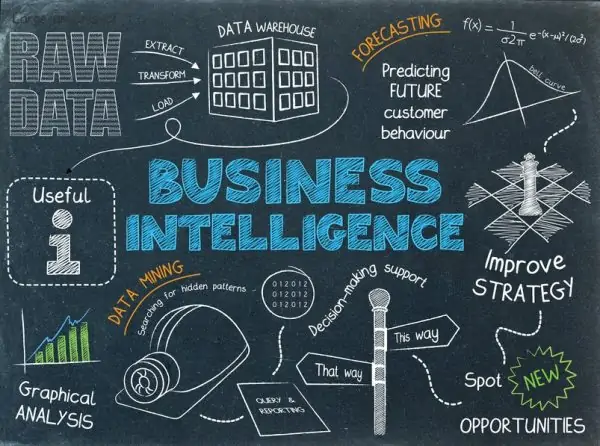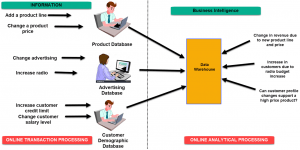BI business intelligence is a set of methods, architectures, and technologies that converts raw information into essential details that drive profitable organization actions. It is a suite of software applications and services to change word into actionable intelligence and understanding.
What Is Business Intelligence? Complete Definition With Example
In this article, you can know about business intelligence here are the details below;
BI has a direct impacts on an organization’s tactical, tactical, and functional organizational choices. BI supports fact based decision making using historical data instead of presumptions and suspicion.
BI tools carry out data analysis and develop reports, summaries, dashboards, maps, charts, and charts to supply users with detailed intelligence about business nature.
Why is BI important?
- – Measurement: creating KPI (Key Performance Indicators) based upon historical data
- – Identify and set criteria for different processes.
- – With BI systems, companies can recognize market patterns and area company problems that need to be addressed.
- – BI assists in information visualization that enhances the information quality and, therefore, the quality of decision making.
- – BI systems can be applied not just by enterprises but SMEs Small and Medium Enterprises.
How are Business Intelligence systems carried out?
Here are the actions.
Step 1) Raw Data from business databases is extracted. The information could be spread throughout several systems heterogeneous systems.
Step 2) The data is cleaned and changed into the information warehouse. The table can be link, and data cubes are formed.
Step 3) Using the BI system, the user can ask quires, request ad-hoc reports, or carry out any other analysis.
Examples of the Business Intelligence System used in Practice.
Example 1.
In an Online Transaction Processing (OLTP) system, details fed into the item database could be.
- – add a line of product.
- – change an item price.
Correspondingly, in a Business Intelligence system inquiry that would be executed for the product discipline could add a new product line or change in product rate boost earnings.
In an advertising database of OLTP system question that could be executed.
- – Changed in ad choices.
- – Increase radio spending plan.
Correspondingly, in the BI system query that could be carried out would be how many brand-new clients were added due to a change in radio budget.
In the OLTP system handling client market databases, information that could be fed would be.
- – boost the customer credit limit.
- – change in client wage level.
Alike in the OLAP system, an inquiry that could be executed would be can client profile changes support greater item rate.
Example 2.
A hotel owner uses BI analytical apps to gather statistical details regarding average occupancy and space rate. It assists in discovering the aggregate profits generated per space.
It likewise collects data on market share and data from customer surveys from each hotel to decides its competitive position in numerous markets.
By analyzing these patterns year by year, month by month, and day by day, it helps management offer discount rates on space leasings.
Example 3.
A bank offers branch managers access to BI applications. It helps the branch manager identify the most rewarding clients and which customers they should work on.
The use of BI tools releases information technology staff from producing analytical reports for the departments. It likewise gives department workers access to a richer data source.
Four types of BI users.
Following given are the 4 key players who are used Business Intelligence System.
1. The Professional Data Analyst.
The information expert is a statistician who continually needs to drills deep down into data. BI system supports them to get fresh insights to establish distinct service methods.
2. The IT users.
The IT user also plays a dominant roles in maintaining the BI infrastructure.
3. The head of the business.
CEO or CXO can increase the revenue of their business by improving operational performance in their business.
4. The Business Users”.
Business intelligence users can be discovered throughout the organization. There are mainly two kinds of service users.
1. Casual business intelligence user.
2. The power user.
The difference between both of them is thats a power user has the capability of working with complicated data sets. In contrast, the casual user need will make him use dashboards to evaluate predefined sets of information.
Advantages of Business Intelligence.
Here are a some of the advantages of using a Business Intelligence System.
1. Increase productivity.
With a BI program, organizations can create reports with a single click; therefore saves excellent time and resources. It likewise enables staff members to be more efficient in their tasks.
2. To enhance visibility.
BI also helps enhance the visibility of these procedures and makes it possible to determine any areas that need attention.
3. Repair Accountability.
BI system designates accountability in the company as there must be somebody who should own responsibility and ownership for the organization’s efficiency against its set goals.
4. It provides a bird’s eye view.
BI system also helps companies choose an overall bird’s eye view through standard BI features like dashboards and scorecards.
5. It improves organization processes.
BI secures all complexity related to service procedures. It likewise automates analytics by providing predictive analysis, computer modeling, benchmarking, and other methods.
6. It allows for simple analytics.
BI software has democratized its use, enabling even nontechnical or non-analysts users to rapidly collect and process information. This also supports putting the power of analytics from the hand’s many people.
BI System Disadvantages.
1. Cost.
Business intelligence can show pricey for small as well as for medium-sized businesses. Using such kind of system may be expensive for routine service transactions.
2. Intricacy.
Another downside of BI is its complexity in the implementation of the data warehouse. It can be so difficult that it can make business methods rigid to deal with.
3. Minimal usage.
Like all enhanced innovations, BI was first established, considering the purchasing competence of wealthy companies. For that reason, the BI system is yet not economical for many small and medium-sized businesses.
4. Time-Consuming Implementation.
It holds approximately one and a half years for a data warehousing system to be carried out. Therefore, it is a time-consuming procedure.
Trends in Business Intelligence.
The following are some businesses intelligence and analytics patterns that you ought to know.
Artificial Intelligence: Gartner’s reports indicates that AI and machine learning now handle complex tasks done by human intelligence. This capability is being leveraged to come up with real time data analysis and control panel reporting.
Collaborative BI: BI software integrated with cooperation tools, consisting of social media and other most current technologies, improves working and sharing by teams for collective decision making.
Embedded BI: Embedded BI enables the combination of BI software application or a few of its features into another organization application for boosting and extending it’s reporting performance.
Cloud Analytics: BI applications will be quickly provided in the cloud, and more companies will be moving to this technology. According to their predictions, within a number of years, the costs of cloud-based analytics will grow 4.5 times faster.
Summary.
- – BI is a set of procedures, architectures, and technologies that transform raw data into significant info that drives rewarding company actions.
- – BI systems assist businesses to determine market trends and area company problems that need to be attended to.
- – BI technology can be utilized by Data analysts, IT individuals, service users, and the head of the company.
- – BI system assists the company to enhance visibility, efficiency, and repair responsibility.
- The draw-backs of BI is that it is a time consuming, costly, and really intricate procedure




